《管理学》课程PPT教学课件(Management, 7th Edition)Chapter 11 MANAGERIAL COMMUNICATION AND INFORMATION TECHNOLOGY
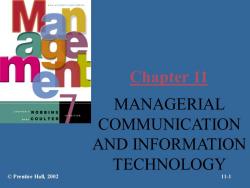
a Chapter 11 MANAGERIAL DROBBI NS E01T10 ACOULTER COMMUNICATION AND INFORMATION TECHNOLOGY ©Prentice Hall,2002 11-1
Chapter 11 MANAGERIAL COMMUNICATION AND INFORMATION TECHNOLOGY © Prentice Hall, 2002 11-1
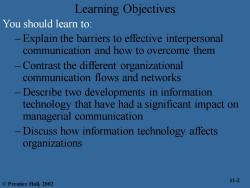
Learning Objectives You should learn to: Explain the barriers to effective interpersonal communication and how to overcome them Contrast the different organizational communication flows and networks Describe two developments in information technology that have had a significant impact on managerial communication -Discuss how information technology affects organizations ©Prentice Hall,2002 11-2
You should learn to: – Explain the barriers to effective interpersonal communication and how to overcome them – Contrast the different organizational communication flows and networks – Describe two developments in information technology that have had a significant impact on managerial communication – Discuss how information technology affects organizations 11-2 © Prentice Hall, 2002 Learning Objectives
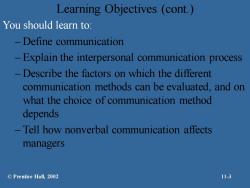
Learning Objectives (cont.) You should learn to: -Define communication Explain the interpersonal communication process Describe the factors on which the different communication methods can be evaluated,and on what the choice of communication method depends Tell how nonverbal communication affects managers ©Prentice Hall,.2002 11-3
Learning Objectives (cont.) You should learn to: – Define communication – Explain the interpersonal communication process – Describe the factors on which the different communication methods can be evaluated, and on what the choice of communication method depends – Tell how nonverbal communication affects managers © Prentice Hall, 2002 11-3
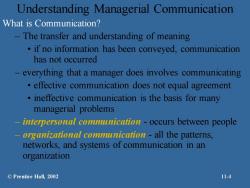
Understanding Managerial Communication What is Communication? The transfer and understanding of meaning if no information has been conveyed,communication has not occurred 一 everything that a manager does involves communicating effective communication does not equal agreement ineffective communication is the basis for many managerial problems interpersonall communication occurs between people organizational communication-all the patterns, networks,and systems of communication in an organi☑ation ©Prentice Hall,.2002 11-4
Understanding Managerial Communication What is Communication? – The transfer and understanding of meaning • if no information has been conveyed, communication has not occurred – everything that a manager does involves communicating • effective communication does not equal agreement • ineffective communication is the basis for many managerial problems – interpersonal communication - occurs between people – organizational communication - all the patterns, networks, and systems of communication in an organization © Prentice Hall, 2002 11-4
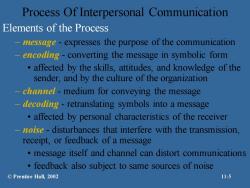
Process Of Interpersonal Communication Elements of the Process -mexge-expresses the purpose of the communication encoding-converting the message in symbolic form affected by the skills,attitudes,and knowledge of the sender,and by the culture of the organization chaanel-medium for conveying the message decodfing-retranslating symbols into a message affected by personal characteristics of the receiver aoke-disturbances that interfere with the transmission, receipt,or feedback of a message message itself and channel can distort communications feedback also subject to same sources of noise ©Prentice Hal,2002 11-5
Process Of Interpersonal Communication Elements of the Process – message - expresses the purpose of the communication – encoding - converting the message in symbolic form • affected by the skills, attitudes, and knowledge of the sender, and by the culture of the organization – channel - medium for conveying the message – decoding - retranslating symbols into a message • affected by personal characteristics of the receiver – noise - disturbances that interfere with the transmission, receipt, or feedback of a message • message itself and channel can distort communications • feedback also subject to same sources of noise © Prentice Hall, 2002 11-5
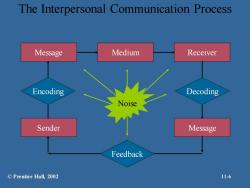
The Interpersonal Communication Process Message Medium Receiver Encoding Decoding Noise Sender Message Feedback ©Prentice Hall,.2002 11-6
The Interpersonal Communication Process Sender Message Medium Receiver Encoding Noise Feedback Message Decoding © Prentice Hall, 2002 11-6

Process Of Interpersonal Communication (cont.) Methods of Communicating Interpersonally -a wide variety of communication methods exist choice of a method should reflect: the needs of the sender the needs of the receiver the attributes of the message the attributes of the channel ©Prentice Hall,2002 11-7
Process Of Interpersonal Communication (cont.) Methods of Communicating Interpersonally – a wide variety of communication methods exist – choice of a method should reflect: – the needs of the sender – the needs of the receiver – the attributes of the message – the attributes of the channel © Prentice Hall, 2002 11-7
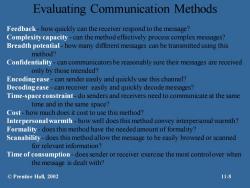
Evaluating Communication Methods FFeedback-how quickly can the receiver respond to the message? Complexity capacity-can the method effectively process complex messages? Breadth potential-how many different messages can be transmitted using this method? Confdentialliy-can communicators be reasonably sure their messages are received only by those intended? EEncoding ease-can sender easily and quickly use this channel? Decodingease-can receiver easily and quickly decode messages? Time-space constraint-do senders and receivers need to communicate at the same time and in the same space? Cost-how much does it cost to use this method? Interpersonal warth-how well does this method convey interpersonal warmth? Formality-does this method have the needed amount of formality? Scanabiity-does this method allow the message to be easily browsed or scanned for relevant information? Time of consumption-does sender or receiver exercise the most control over when the message is dealt with? ©Prentice Hall,2002 11-8
Evaluating Communication Methods Feedback - how quickly can the receiver respond to the message? Complexity capacity - can the method effectively process complex messages? Breadth potential- how many different messages can be transmitted using this method? Confidentiality - can communicators be reasonably sure their messages are received only by those intended? Encoding ease - can sender easily and quickly use this channel? Decoding ease - can receiver easily and quickly decode messages? Time-space constraint- do senders and receivers need to communicate at the same time and in the same space? Cost- how much does it cost to use this method? Interpersonal warmth - how well does this method convey interpersonal warmth? Formality - does this method have the needed amount of formality? Scanability - does this method allow the message to be easily browsed or scanned for relevant information? Time of consumption - does sender or receiver exercise the most control over when the message is dealt with? © Prentice Hall, 2002 11-8
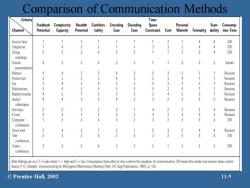
Comparison of Communication Methods Criteria Time- Feedback Complexity Breadth Confiden-Encoding Decoding Space Personal Scan-Consump Channel Potential Capacity Potential tiality Ease Ease Constraint Cost Warmth Formality ability tion Time Face-to-face 1 1 S/R Telephone 1 2 4 4 S/R Group 2 2 2 3 4 S/R meetings Formal 4 2 3 5 Sender presentations Memos 4 2 1 Receiver Postal mail 5 1 Receiver Fax 3 3 Receiver Publications 5 1 1 Receiver Bulletin boards 4 3 1 Receiver Audiol 4 Receiver videotapes Hot lines 2 Receiver Email 3 3 4 Receiver Computer 1 3 4 S/R conference Voice mail 2 2 4 Receiver Tele 2 3 2 3 3 S/R conference Video 3 2 2 2 3 S/R conference Nore:Ratings are on a 1-5 scale where 1=high and 5=low.Consumption time refers to who controls the reception of communication.S/R means the sender and recenve share control. PG.Clampitt Communcatngfor Mangrial Ecivness (Newbury Park CA:Sae Publications 1991).p.136. ©Prentice Hall,2002 11-9
Comparison of Communication Methods © Prentice Hall, 2002 11-9

Process Of Interpersonal Communication (cont. Methods of Communicating Interpersonally (cont.) nonverbal communication -communication without words ·types -body language-gestures,facial expressions,and other body movements that convey meaning verbal intonation emphasis someone gives to words or phrases that conveys meaning every oral communication is accompanied by a nonverbal message nonverbal component usually carries the greatest impact ©Prentice Hall,.2002 11-10
Process Of Interpersonal Communication (cont.) Methods of Communicating Interpersonally (cont.) – nonverbal communication - communication without words • types – body language - gestures, facial expressions, and other body movements that convey meaning – verbal intonation - emphasis someone gives to words or phrases that conveys meaning • every oral communication is accompanied by a nonverbal message • nonverbal component usually carries the greatest impact © Prentice Hall, 2002 11-10
按次数下载不扣除下载券;
注册用户24小时内重复下载只扣除一次;
顺序:VIP每日次数-->可用次数-->下载券;
- 《管理学》课程PPT教学课件(Management, 7th Edition)Chapter 10 ORGANIZATIONAL STRUCTURE AND DESIGN.ppt
- 《管理学》课程PPT教学课件(Management, 7th Edition)Chapter 09 PLANNING TOOLS AND TECHNIQUES.ppt
- 《管理学》课程PPT教学课件(Management, 7th Edition)Chapter 08 STRATEGIC MANAGEMENT.ppt
- 《管理学》课程PPT教学课件(Management, 7th Edition)Chapter 07 FOUNDATIONS OF PLANNING.ppt
- 《管理学》课程PPT教学课件(Management, 7th Edition)Chapter 06 DECISION MAKING:THE ESSENCE OF THE MANAGER’S JOB.ppt
- 《管理学》课程教学资源(课件讲义)Stephen P.Robbins(9)Chapter 2 Management Yesterday and Today.pdf
- 《管理学》课程教学资源(课件讲义)Stephen P.Robbins(9)Chapter 1 Introduction to Management and Organizations.pdf
- 《管理学》课程教学资源(教师手册)Stephen P.Robbins(9)CHAPTER TWO Management Yesterday.pdf
- 《管理学》课程教学资源(教师手册)Stephen P.Robbins(9)CHAPTER ONE Introduction to Management.pdf
- 《管理学》课程PPT教学课件(Management)Stephen P.Robbins(9)第十二章 人力资源管理 Human Resource Management.ppt
- 《管理学》课程PPT教学课件(Management)Stephen P.Robbins(9)第十章 组织结构与设计 Organizational Structure and Design.ppt
- 《管理学》课程PPT教学课件(Management)Stephen P.Robbins(9)第十五章 理解群体与团队 Understanding Groups and Teams.ppt
- 《管理学》课程PPT教学课件(Management)Stephen P.Robbins(9)第十九章 运营及价值链管理 Operations and Value Chain Management.ppt
- 《管理学》课程PPT教学课件(Management)Stephen P.Robbins(9)第三章 组织文化与环境——约束力量 Organizational Culture and Environment - The Constraints.ppt
- 《管理学》课程PPT教学课件(Management)Stephen P.Robbins(9)第二章 管理的昨天和今天 Management Yesterday and Today.ppt
- 《管理学》课程PPT教学课件(Management)Stephen P.Robbins(9)第五章 社会责任与道德管理 Social Responsibility and Managerial Ethics.ppt
- 《管理学》课程PPT教学课件(Management)Stephen P.Robbins(9)第四章 全球环境中的管理 Managing in a Global Environment.ppt
- 《管理学》课程PPT教学课件(Management)Stephen P.Robbins(9)第六章 制定决策——管理者工作的实质 Decision-Making - The Essence of the Manager’s Job.ppt
- 《管理学》课程PPT教学课件(Management)Stephen P.Robbins(9)第八章 战略管理 Strategic Management.ppt
- 《管理学》课程PPT教学课件(Management)Stephen P.Robbins(9)第十六章 激励员工 Motivating Employees.ppt
- 《管理学》课程PPT教学课件(Management, 7th Edition)Chapter 12 HUMAN RESOURCE MANAGEMENT(HRM).ppt
- 《管理学》课程PPT教学课件(Management, 7th Edition)Chapter 13 MANAGING CHANGE AND INNOVATION.ppt
- 《管理学》课程PPT教学课件(Management, 7th Edition)Chapter 14 FOUNDATIONS OF BEHAVIOR.ppt
- 《管理学》课程PPT教学课件(Management, 7th Edition)Chapter 15 UNDERSTANDING GROUPS AND TEAMS.ppt
- 《管理学》课程PPT教学课件(Management, 7th Edition)Chapter 16 MOTIVATING EMPLOYEES.ppt
- 《管理学》课程PPT教学课件(Management, 7th Edition)Chapter 18 FOUNDATIONS OF CONTROL.ppt
- 《管理学》课程PPT教学课件(Management, 7th Edition)Chapter 19 OPERATIONS AND VALUE CHAIN MANAGEMENT.ppt
- 《管理学》课程PPT教学课件(Management, 7th Edition)Chapter 20 CONTROLLING FOR ORGANIZATIONAL PERFORMANCE.ppt
- 《管理学》课程教学资源(实验讲义)企业竞争模拟攻略篇.pdf
- 《管理学》课程教学资源(习题与答案)第1章 管理活动与管理理论.doc
- 《管理学》课程教学资源(习题与答案)第3章 全球化与管理.doc
- 《管理学》课程教学资源(习题与答案)第6章 计划与计划工作.doc
- 《管理学》课程教学资源(习题与答案)第十章 组织变革与组织文化.doc
- 《管理学》课程教学资源(习题与答案)第16章 管理的创新职能.doc
- 《管理学》课程教学资源(习题与答案)第1章 管理活动与管理理论.doc
- 《管理学》课程教学资源(习题与答案)第3章 全球化与管理.doc
- 《管理学》课程教学资源(习题与答案)第4章 信息与信息化管理.doc
- 《管理学》课程教学资源(习题与答案)第5章 决策与决策方法.doc
- 《管理学》课程教学资源(习题与答案)第6章 计划与计划工作.doc
- 《管理学》课程教学资源(习题与答案)第7章 战略性计划与战略实施.doc
